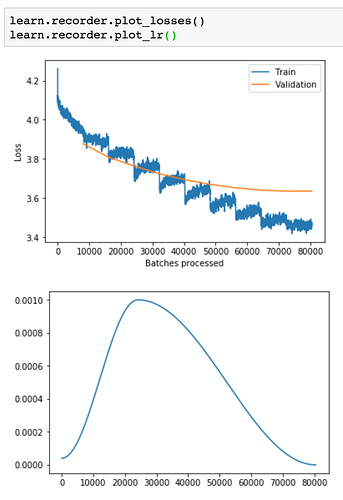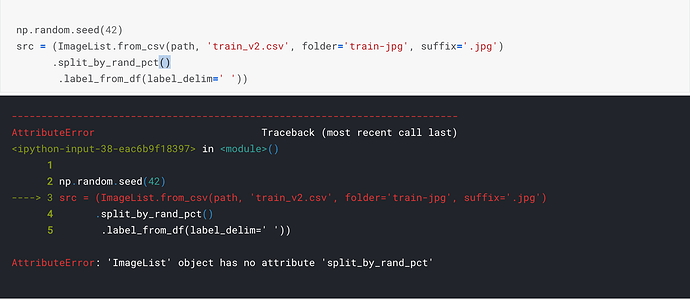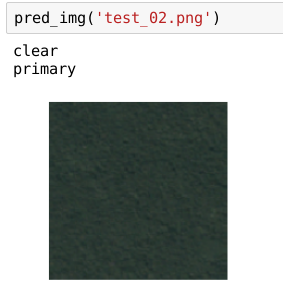EDIT: The error mysteriously disappeared today after I open the notebook again, not sure why.
Hi,
I am working on lesson3-planet notebook. I am trying to load the dataset from kaggle using:
df = pd.read_csv(path/'train_v2.csv')
df.head()
I got the following error:
TypeError Traceback (most recent call last)
/usr/local/lib/python3.6/dist-packages/IPython/core/formatters.py in __call__(self, obj)
697 type_pprinters=self.type_printers,
698 deferred_pprinters=self.deferred_printers)
--> 699 printer.pretty(obj)
700 printer.flush()
701 return stream.getvalue()
/usr/local/lib/python3.6/dist-packages/IPython/lib/pretty.py in pretty(self, obj)
396 if callable(meth):
397 return meth(obj, self, cycle)
--> 398 return _default_pprint(obj, self, cycle)
399 finally:
400 self.end_group()
/usr/local/lib/python3.6/dist-packages/IPython/lib/pretty.py in _default_pprint(obj, p, cycle)
516 if _safe_getattr(klass, '__repr__', None) not in _baseclass_reprs:
517 # A user-provided repr. Find newlines and replace them with p.break_()
--> 518 _repr_pprint(obj, p, cycle)
519 return
520 p.begin_group(1, '<')
/usr/local/lib/python3.6/dist-packages/IPython/lib/pretty.py in _repr_pprint(obj, p, cycle)
707 """A pprint that just redirects to the normal repr function."""
708 # Find newlines and replace them with p.break_()
--> 709 output = repr(obj)
710 for idx,output_line in enumerate(output.splitlines()):
711 if idx:
/usr/local/lib/python3.6/dist-packages/pandas/core/base.py in __repr__(self)
78 Yields Bytestring in Py2, Unicode String in py3.
79 """
---> 80 return str(self)
81
82
/usr/local/lib/python3.6/dist-packages/pandas/core/base.py in __str__(self)
57
58 if compat.PY3:
---> 59 return self.__unicode__()
60 return self.__bytes__()
61
/usr/local/lib/python3.6/dist-packages/pandas/core/frame.py in __unicode__(self)
634 width = None
635 self.to_string(buf=buf, max_rows=max_rows, max_cols=max_cols,
--> 636 line_width=width, show_dimensions=show_dimensions)
637
638 return buf.getvalue()
/usr/local/lib/python3.6/dist-packages/pandas/core/frame.py in to_string(self, buf, columns, col_space, header, index, na_rep, formatters, float_format, sparsify, index_names, justify, line_width, max_rows, max_cols, show_dimensions)
1673 max_cols=max_cols,
1674 show_dimensions=show_dimensions)
-> 1675 formatter.to_string()
1676
1677 if buf is None:
/usr/local/lib/python3.6/dist-packages/pandas/io/formats/format.py in to_string(self)
601 elif (not isinstance(self.max_cols, int) or
602 self.max_cols > 0): # need to wrap around
--> 603 text = self._join_multiline(*strcols)
604 else: # max_cols == 0. Try to fit frame to terminal
605 text = self.adj.adjoin(1, *strcols).split('\n')
/usr/local/lib/python3.6/dist-packages/pandas/io/formats/format.py in _join_multiline(self, *strcols)
648 idx = strcols.pop(0)
649 lwidth -= np.array([self.adj.len(x)
--> 650 for x in idx]).max() + adjoin_width
651
652 col_widths = [np.array([self.adj.len(x) for x in col]).max() if
/usr/local/lib/python3.6/dist-packages/numpy/core/_methods.py in _amax(a, axis, out, keepdims, initial)
26 def _amax(a, axis=None, out=None, keepdims=False,
27 initial=_NoValue):
---> 28 return umr_maximum(a, axis, None, out, keepdims, initial)
29
30 def _amin(a, axis=None, out=None, keepdims=False,
TypeError: reduce() takes at most 5 arguments (6 given)
Apparently, it comes from trying to display the data frame. Any suggestion here?



 You will not exactly initialize with a resnet, you will create a new network that is very similar to Resnet in encoding pass, but saves the activations on some steps so that you can concat them with the input in the decode pass. There is a lesson in dl2 2018 about that. It is about segmentation on carvana dataset. Check the video.
You will not exactly initialize with a resnet, you will create a new network that is very similar to Resnet in encoding pass, but saves the activations on some steps so that you can concat them with the input in the decode pass. There is a lesson in dl2 2018 about that. It is about segmentation on carvana dataset. Check the video.